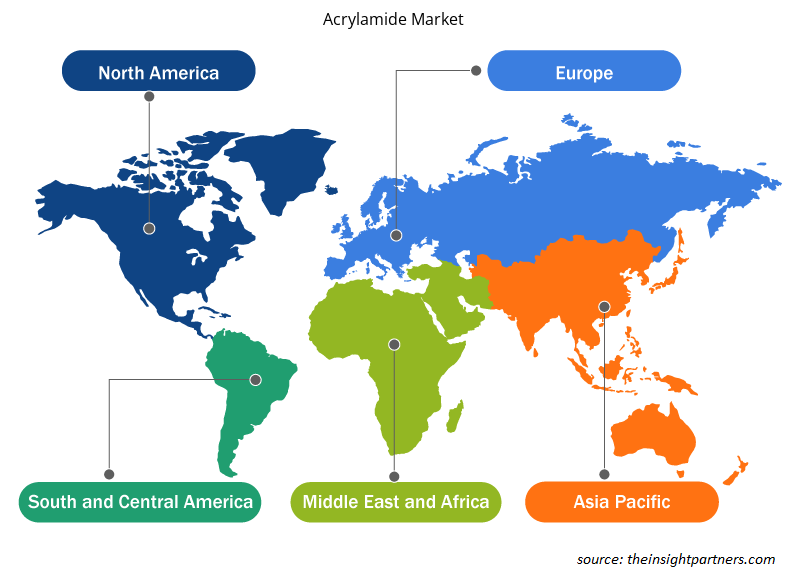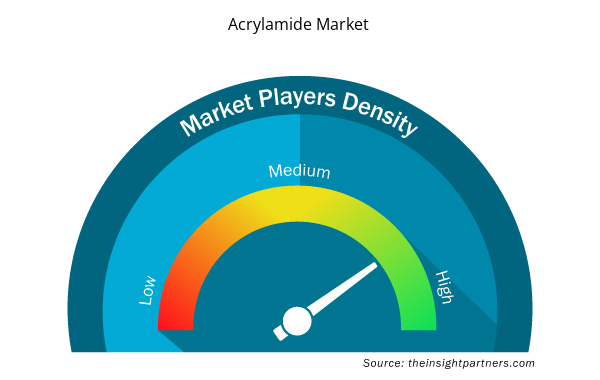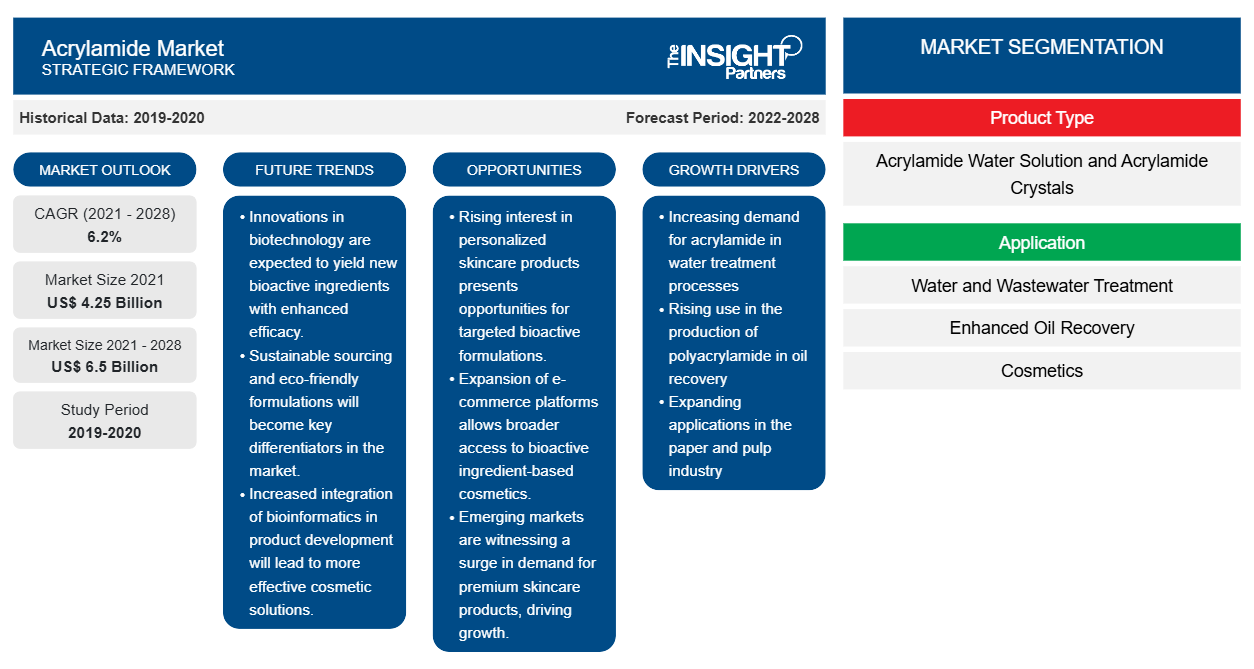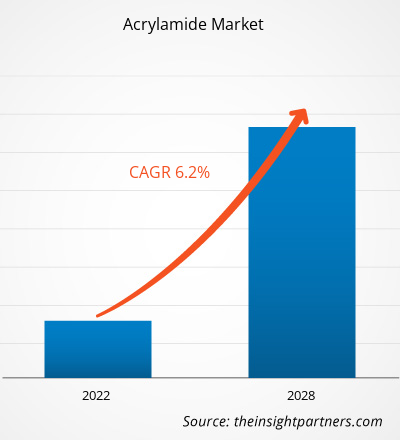Se espera que el mercado de acrilamida crezca de US$ 4.254,16 millones en 2021 a US$ 6.500,22 millones en 2028; se estima que crecerá a una CAGR del 6,2% entre 2021 y 2028.
La acrilamida es una sustancia química orgánica e inodora que se encuentra disponible en forma líquida y cristalina. Es soluble en agua y en diversos solventes orgánicos. Es un precursor de las poliacrilamidas que tienen varias aplicaciones como espesantes solubles en agua y agentes de floculación.
En 2020, Asia Pacífico dominó el mercado mundial de acrilamida y se espera que mantenga su dominio durante el período de pronóstico. Japón y China son los principales fabricantes de acrilamida y representan una parte importante de la capacidad instalada mundial. El aumento del apoyo gubernamental al tratamiento de aguas residuales en países como India y China, y la creciente industria del cuidado personal y la cosmética en la región están impulsando el crecimiento del mercado en Asia Pacífico. La industria del cuidado personal en la región está creciendo debido al aumento de la población de ingresos medios, el aumento del ingreso per cápita, la mejora del nivel de vida y el aumento de la población de mujeres trabajadoras. Por lo tanto, la creciente industria del cuidado personal ha provocado un aumento de la demanda de acrilamida, ya que se usa ampliamente como estabilizador, aglutinante y espesante en cosméticos y productos de cuidado personal. Junto con esto, se espera que América del Norte sea la segunda región de más rápido crecimiento, lo que se debe al aumento de la inversión en el tratamiento de aguas residuales, así como a un aumento de la demanda de acrilamida del sector de la recuperación mejorada de petróleo y la cosmética. También se espera que Europa sea testigo de un crecimiento considerable durante el período de pronóstico.
Personalice este informe según sus necesidades
Obtendrá personalización en cualquier informe, sin cargo, incluidas partes de este informe o análisis a nivel de país, paquete de datos de Excel, así como también grandes ofertas y descuentos para empresas emergentes y universidades.
- Obtenga las principales tendencias clave del mercado de este informe.Esta muestra GRATUITA incluirá análisis de datos, desde tendencias del mercado hasta estimaciones y pronósticos.
Perspectivas del mercado
Demanda creciente de tratamiento de aguas residuales
El fuerte crecimiento económico, el aumento de la población y la rápida urbanización en todo el mundo han provocado un aumento del consumo de agua potable y de la generación de aguas residuales. Varios países han aplicado normas estrictas contra la contaminación de los cuerpos de agua y el vertido ilegal de aguas residuales. En países como China, que sufre la contaminación del aire, se han aplicado leyes especiales para protegerlo del impacto nocivo del vertido de aguas residuales. La gestión de las aguas residuales industriales se ha convertido en una preocupación crucial entre los organismos reguladores, ya que los efluentes industriales incluyen productos químicos nocivos que pueden provocar riesgos para la salud y perjudicar la biodiversidad marina. Por tanto, el aumento de la demanda de tratamiento de aguas residuales en todo el mundo está impulsando el crecimiento del mercado.
Información sobre el tipo de producto
Según el tipo de producto, el mercado se divide en soluciones acuosas de acrilamida y cristales de acrilamida. En 2020, el segmento de cristales de acrilamida fue el de mayor crecimiento en el mercado de la acrilamida. Los cristales de acrilamida tienen diversas aplicaciones y se utilizan como floculante, agente de bloqueo, agente de tratamiento textil y agente de tratamiento de agua.flocculant, blocking agent, textile treatment agent, and water treatment agent.
Ashland Global Holding Inc.; SNF; Kemira OYJ; BASF SE; EMCO Dyestuff; Mitsui Chemicals Global, Pvt. Ltd.; Ineos AG; Solvay; Nuoer Group; y Black Rose Industries Ltd.; se encuentran entre los actores clave que operan en el mercado global. Los principales actores adoptan varias estrategias, como fusiones y adquisiciones, y lanzamientos de productos, para expandir su presencia geográfica y su base de consumidores.
Perspectivas regionales del mercado de acrilamida
Los analistas de Insight Partners explicaron en detalle las tendencias y los factores regionales que influyen en el mercado de la acrilamida durante el período de pronóstico. Esta sección también analiza los segmentos y la geografía del mercado de la acrilamida en América del Norte, Europa, Asia Pacífico, Oriente Medio y África, y América del Sur y Central.

- Obtenga datos regionales específicos para el mercado de acrilamida
Alcance del informe de mercado de acrilamida
| Atributo del informe | Detalles |
|---|---|
| Tamaño del mercado en 2021 | 4.250 millones de dólares estadounidenses |
| Tamaño del mercado en 2028 | 6.500 millones de dólares estadounidenses |
| CAGR global (2021-2028) | 6,2% |
| Datos históricos | 2019-2020 |
| Período de pronóstico | 2022-2028 |
| Segmentos cubiertos | Por tipo de producto
|
| Regiones y países cubiertos | América del norte
|
| Líderes del mercado y perfiles de empresas clave |
|
Densidad de actores del mercado de acrilamida: comprensión de su impacto en la dinámica empresarial
El mercado de la acrilamida está creciendo rápidamente, impulsado por la creciente demanda de los usuarios finales debido a factores como la evolución de las preferencias de los consumidores, los avances tecnológicos y una mayor conciencia de los beneficios del producto. A medida que aumenta la demanda, las empresas amplían sus ofertas, innovan para satisfacer las necesidades de los consumidores y aprovechan las tendencias emergentes, lo que impulsa aún más el crecimiento del mercado.
La densidad de actores del mercado se refiere a la distribución de las empresas o firmas que operan dentro de un mercado o industria en particular. Indica cuántos competidores (actores del mercado) están presentes en un espacio de mercado determinado en relación con su tamaño o valor total de mercado.
Las principales empresas que operan en el mercado de acrilamida son:
- INEOS Styrolution India Limited
- Compañía: Ashland Global Holdings Inc.
- Enfermería no especializada
- Compañía Kemira
- BASF SE
Descargo de responsabilidad : Las empresas enumeradas anteriormente no están clasificadas en ningún orden particular.

- Obtenga una descripción general de los principales actores clave del mercado de acrilamida
Informe Destacado
- Tendencias progresivas en la industria de la acrilamida para ayudar a los actores a desarrollar estrategias efectivas a largo plazo
- Estrategias de crecimiento empresarial adoptadas por las empresas para asegurar el crecimiento en los mercados desarrollados y en desarrollo
- Análisis cuantitativo del mercado mundial de acrilamida de 2019 a 2028
- Estimación de la demanda de acrilamida en diversas industrias
- Análisis de Porter para ilustrar la eficacia de los compradores y proveedores que operan en la industria para predecir el crecimiento del mercado.
- Desarrollos recientes para comprender el escenario competitivo del mercado y la demanda de acrilamida
- Tendencias y perspectivas del mercado junto con los factores que impulsan y restringen el crecimiento del mercado de acrilamida
- Comprensión de las estrategias que sustentan el interés comercial con respecto al crecimiento del mercado global de acrilamida, ayudando en el proceso de toma de decisiones.
- Tamaño del mercado de acrilamida en varios nodos del mercado
- Descripción detallada y segmentación del mercado mundial de acrilamida, así como su dinámica industrial
- Tamaño del mercado de acrilamida en varias regiones con oportunidades de crecimiento prometedoras
El "Análisis del mercado global de acrilamida hasta 2028" es un estudio especializado y profundo de la industria de productos químicos y materiales, que se centra en el análisis de las tendencias del mercado global de acrilamida. El informe tiene como objetivo proporcionar una descripción general del mercado con una segmentación detallada del mercado. El mercado de acrilamida está segmentado en función del tipo de producto, la aplicación y la geografía. Según el tipo de producto, el mercado se bifurca en solución de agua de acrilamida y cristales de acrilamida. Según la aplicación, el mercado se segmenta en tratamiento de agua y aguas residuales, recuperación mejorada de petróleo , cosméticos, fabricación de papel, productos químicos intermedios, textiles y otros. Según la geografía, el mercado está segmentado en cinco regiones principales: América del Norte, Europa, Asia Pacífico, Oriente Medio y África, y América del Sur y Central. La acrilamida se utiliza para fabricar polímero de acrilamida (poliacrilamida) que se utiliza como floculante en el tratamiento de aguas residuales. Coagula la materia orgánica que se puede eliminar por filtración. El creciente desarrollo de instalaciones de tratamiento de aguas residuales en todo el mundo está incrementando la demanda de acrilamida.
Perfiles de empresas
- Compañía: Ashland Global Holding Inc.
- Enfermería no especializada
- Kemira OYJ
- BASF SE
- Colorante EMCO
- Compañía química Mitsui Global, Pvt. Ltd.
- Ineos AG
- Solvay
- Grupo Nuoer
- Industrias Rosa Negra Ltd.;
- Análisis histórico (2 años), año base, pronóstico (7 años) con CAGR
- Análisis PEST y FODA
- Tamaño del mercado Valor/volumen: global, regional, nacional
- Industria y panorama competitivo
- Conjunto de datos de Excel


- Quantitative Structure-Activity Relationship (QSAR) Market
- Aquaculture Market
- Micro-Surgical Robot Market
- Retinal Imaging Devices Market
- Nurse Call Systems Market
- Analog-to-Digital Converter Market
- Machine Condition Monitoring Market
- Formwork System Market
- Antibiotics Market
- Arterial Blood Gas Kits Market

Report Coverage
Revenue forecast, Company Analysis, Industry landscape, Growth factors, and Trends

Segment Covered
This text is related
to segments covered.

Regional Scope
North America, Europe, Asia Pacific, Middle East & Africa, South & Central America

Country Scope
This text is related
to country scope.
Preguntas frecuentes
The global acrylamide market is primarily driven rising demand for wastewater treatment and rapid growth of the chemicals and materials industry globally.
Based on application, the water and wastewater treatment segment held the largest share in the global acrylamide market. Acrylamide is used to manufacture acrylamide polymer (polyacrylamide) which is used as a flocculent in wastewater treatment.
Based on product type, the acrylamide crystals segment held the largest share in the acrylamide market. It is a precursor to polyacrylamides that have a wide range of applications as water-soluble thickeners and flocculation agents.
In 2020, Asia-Pacific led the global acrylamide market. The increasing focus on municipal and industrial wastewater treatment is driving the demand for acrylamide in the region. Moreover, the governments are also investing in sewage treatment plants to promote the reuse and recycling of water.
Acrylamide is used to manufacture acrylamide polymer (polyacrylamide) which is used as a flocculent in wastewater treatment. It coagulates the organic matter which can be removed by filtration.
Some of the prominent players operating in the global acrylamide market include INEOS, Ashland Global Holdings Inc., SNF, Kemira Oyj, BASF SE, Black Rose Industries Ltd, Mitsui Chemicals India Pvt. Ltd., Solvay S.A., NUOER GROUP and EMCO Dyestuff, among others.
Trends and growth analysis reports related to Chemicals and Materials : READ MORE..
The List of Companies - Acrylamide Market
- INEOS Styrolution India Limited
- Ashland Global Holdings Inc.
- SNF
- Kemira Oyj
- BASF SE
- Black Rose Industries Ltd
- Mitsui Chemicals India Pvt. Ltd.
- Solvay S.A.
- NUOER GROUP
- EMCO Dyestuff
The Insight Partners performs research in 4 major stages: Data Collection & Secondary Research, Primary Research, Data Analysis and Data Triangulation & Final Review.
- Data Collection and Secondary Research:
As a market research and consulting firm operating from a decade, we have published and advised several client across the globe. First step for any study will start with an assessment of currently available data and insights from existing reports. Further, historical and current market information is collected from Investor Presentations, Annual Reports, SEC Filings, etc., and other information related to company’s performance and market positioning are gathered from Paid Databases (Factiva, Hoovers, and Reuters) and various other publications available in public domain.
Several associations trade associates, technical forums, institutes, societies and organization are accessed to gain technical as well as market related insights through their publications such as research papers, blogs and press releases related to the studies are referred to get cues about the market. Further, white papers, journals, magazines, and other news articles published in last 3 years are scrutinized and analyzed to understand the current market trends.
- Primary Research:
The primarily interview analysis comprise of data obtained from industry participants interview and answers to survey questions gathered by in-house primary team.
For primary research, interviews are conducted with industry experts/CEOs/Marketing Managers/VPs/Subject Matter Experts from both demand and supply side to get a 360-degree view of the market. The primary team conducts several interviews based on the complexity of the markets to understand the various market trends and dynamics which makes research more credible and precise.
A typical research interview fulfils the following functions:
- Provides first-hand information on the market size, market trends, growth trends, competitive landscape, and outlook
- Validates and strengthens in-house secondary research findings
- Develops the analysis team’s expertise and market understanding
Primary research involves email interactions and telephone interviews for each market, category, segment, and sub-segment across geographies. The participants who typically take part in such a process include, but are not limited to:
- Industry participants: VPs, business development managers, market intelligence managers and national sales managers
- Outside experts: Valuation experts, research analysts and key opinion leaders specializing in the electronics and semiconductor industry.
Below is the breakup of our primary respondents by company, designation, and region:

Once we receive the confirmation from primary research sources or primary respondents, we finalize the base year market estimation and forecast the data as per the macroeconomic and microeconomic factors assessed during data collection.
- Data Analysis:
Once data is validated through both secondary as well as primary respondents, we finalize the market estimations by hypothesis formulation and factor analysis at regional and country level.
- Macro-Economic Factor Analysis:
We analyse macroeconomic indicators such the gross domestic product (GDP), increase in the demand for goods and services across industries, technological advancement, regional economic growth, governmental policies, the influence of COVID-19, PEST analysis, and other aspects. This analysis aids in setting benchmarks for various nations/regions and approximating market splits. Additionally, the general trend of the aforementioned components aid in determining the market's development possibilities.
- Country Level Data:
Various factors that are especially aligned to the country are taken into account to determine the market size for a certain area and country, including the presence of vendors, such as headquarters and offices, the country's GDP, demand patterns, and industry growth. To comprehend the market dynamics for the nation, a number of growth variables, inhibitors, application areas, and current market trends are researched. The aforementioned elements aid in determining the country's overall market's growth potential.
- Company Profile:
The “Table of Contents” is formulated by listing and analyzing more than 25 - 30 companies operating in the market ecosystem across geographies. However, we profile only 10 companies as a standard practice in our syndicate reports. These 10 companies comprise leading, emerging, and regional players. Nonetheless, our analysis is not restricted to the 10 listed companies, we also analyze other companies present in the market to develop a holistic view and understand the prevailing trends. The “Company Profiles” section in the report covers key facts, business description, products & services, financial information, SWOT analysis, and key developments. The financial information presented is extracted from the annual reports and official documents of the publicly listed companies. Upon collecting the information for the sections of respective companies, we verify them via various primary sources and then compile the data in respective company profiles. The company level information helps us in deriving the base number as well as in forecasting the market size.
- Developing Base Number:
Aggregation of sales statistics (2020-2022) and macro-economic factor, and other secondary and primary research insights are utilized to arrive at base number and related market shares for 2022. The data gaps are identified in this step and relevant market data is analyzed, collected from paid primary interviews or databases. On finalizing the base year market size, forecasts are developed on the basis of macro-economic, industry and market growth factors and company level analysis.
- Data Triangulation and Final Review:
The market findings and base year market size calculations are validated from supply as well as demand side. Demand side validations are based on macro-economic factor analysis and benchmarks for respective regions and countries. In case of supply side validations, revenues of major companies are estimated (in case not available) based on industry benchmark, approximate number of employees, product portfolio, and primary interviews revenues are gathered. Further revenue from target product/service segment is assessed to avoid overshooting of market statistics. In case of heavy deviations between supply and demand side values, all thes steps are repeated to achieve synchronization.
We follow an iterative model, wherein we share our research findings with Subject Matter Experts (SME’s) and Key Opinion Leaders (KOLs) until consensus view of the market is not formulated – this model negates any drastic deviation in the opinions of experts. Only validated and universally acceptable research findings are quoted in our reports.
We have important check points that we use to validate our research findings – which we call – data triangulation, where we validate the information, we generate from secondary sources with primary interviews and then we re-validate with our internal data bases and Subject matter experts. This comprehensive model enables us to deliver high quality, reliable data in shortest possible time.


 Obtenga una muestra gratuita de este informe
Obtenga una muestra gratuita de este informe